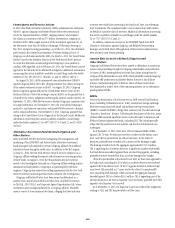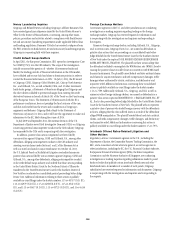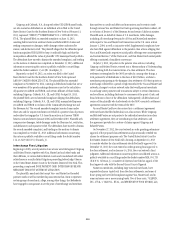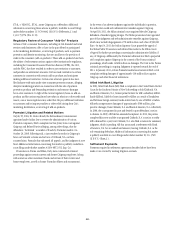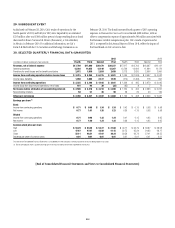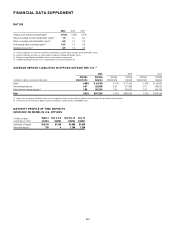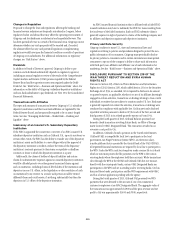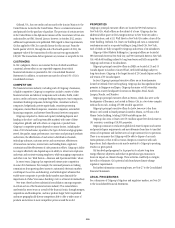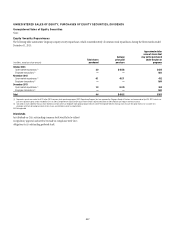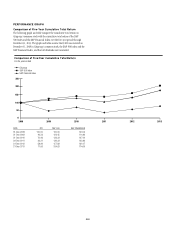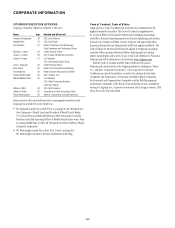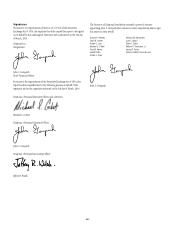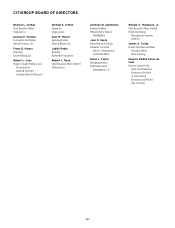Citibank 2013 Annual Report Download - page 334
Download and view the complete annual report
Please find page 334 of the 2013 Citibank annual report below. You can navigate through the pages in the report by either clicking on the pages listed below, or by using the keyword search tool below to find specific information within the annual report.316
Citibank, N.A., has one credit card account for the Iranian Mission to the
United Nations located in the United States. This is a commercial account
used primarily for the purchase of gasoline. The provision of certain services
in the United States to the diplomatic mission of the Government of Iran was
authorized by an OFAC General License, however, in October 2012, certain
additional requirements were published. With regard to these requirements,
Citi has applied to OFAC for a specific license for this account. From the
fourth quarter of 2012, through the end of the fourth quarter of 2013, the
aggregate value of the transactions for this account was approximately
$18,300. The transactions did not generate any revenue or net profit for Citi.
CUSTOMERS
In Citi’s judgment, there is no customer the loss of which would have
a material adverse effect on any reportable segment about which
financial information is presented in Citi’s Consolidated Financial
Statements. In addition, no customer accounts for at least 10% of Citi’s
consolidated revenues.
COMPETITION
The financial services industry, including each of Citigroup’s businesses,
is highly competitive. Citigroup’s competitors include a variety of other
financial services and advisory companies such as banks, thrifts, credit
unions, credit card issuers, mortgage banking companies, trust companies,
investment banking companies, brokerage firms, investment advisory
companies, hedge funds, private equity funds, securities processing
companies, mutual fund companies, insurance companies, automobile
financing companies, and internet-based financial services companies.
Citigroup competes for clients and capital (including deposits and
funding in the short- and long-term debt markets) with some of these
competitors globally and with others on a regional or product basis.
Citigroup’s competitive position depends on many factors, including the
value of Citi’s brand name, reputation, the types of clients and geographies
served, the quality, range, performance, innovation and pricing of products
and services, the effectiveness of and access to distribution channels,
technology advances, customer service and convenience, effectiveness
of transaction execution, interest rates and lending limits, regulatory
constraints and the effectiveness of sales promotion efforts. Citigroup’s ability
to compete effectively also depends upon its ability to attract new employees
and retain and motivate existing employees, while managing compensation
and other costs. See “Risk Factors—Business and Operational Risks” above.
In recent years, Citigroup has experienced intense price competition
in some of its businesses. For example, the increased pressure on trading
commissions from growing direct access to automated, electronic markets
could impact Securities and Banking, and technological advances that
enable more companies to provide funds transfers may diminish the
importance of Global Consumer Banking’s role as a financial intermediary.
Over time, there has been substantial consolidation among companies
in certain sectors of the financial services industry. This consolidation
accelerated in recent years as a result of the financial crisis, through mergers,
acquisitions and bankruptcies, and may produce larger, better capitalized
and more geographically diverse competitors able to offer a wider array of
products and services at more competitive prices around the world.
PROPERTIES
Citigroup’s principal executive offices are located at 399 Park Avenue in
New York City, which offices are the subject of a lease. Citigroup also has
additional office space at 601 Lexington Avenue in New York City under a
long-term lease, and at 111 Wall Street in New York City under a lease of the
entire building. Citibank, N.A. leases one building and owns a commercial
condominium unit in a separate building in Long Island City, New York,
each of which are fully occupied by Citigroup and certain of its subsidiaries.
Citigroup Global Markets Holdings Inc.’s principal offices are located at
388 Greenwich Street in New York City, and 390 Greenwich Street in New York
City, with both buildings subject to long term-leases and fully occupied by
Citigroup and certain of its subsidiaries.
Citigroup’s principal executive offices in EMEA are located at 25 and 33
Canada Square in London’s Canary Wharf, with both buildings subject to
long-term leases. Citigroup is the largest tenant of 25 Canada Square and the
sole tenant of 33 Canada Square.
In Asia, Citigroup’s principal executive offices are in leased premises
located at Citibank Tower in Hong Kong. Citigroup also has significant lease
premises in Singapore and Japan. Citigroup has major or full ownership
interests in country headquarter locations in Shanghai, Seoul, Kuala
Lumpur, Manila, and Mumbai.
Citigroup’s principal executive offices in Mexico, which also serve as the
headquarters of Banamex, are located in Mexico City, in a two-tower complex
with six floors each, totaling 257,000 rentable square feet.
Citigroup’s principal executive offices for Latin America (other than
Mexico) are located in leased premises located in Miami, on 9 floors at the
Miami Center building, totaling 158,000 rentable square feet.
Citigroup also owns or leases over 69.3 million square feet of real estate in
101 countries, consisting of 10,855 properties.
Citigroup continues to evaluate its global real estate footprint and current
and projected space requirements and may determine from time to time that
certain of its premises and facilities are no longer necessary for its operations.
There is no assurance that Citigroup will be able to dispose of any such
excess premises or that it will not incur charges in connection with such
dispositions. Such disposition costs may be material to Citigroup’s operating
results in a given period.
Citi has developed programs for its properties to achieve long-term
energy efficiency objectives and reduce its greenhouse gas emissions to
lessen its impact on climate change. These activities could help to mitigate,
but will not eliminate, Citi’s potential risk from future climate change
regulatory requirements.
For further information concerning leases, see Note 27 to the Consolidated
Financial Statements.
LEGAL PROCEEDINGS
For a discussion of Citigroup’s litigation and regulatory matters, see Note 28
to the Consolidated Financial Statements.


